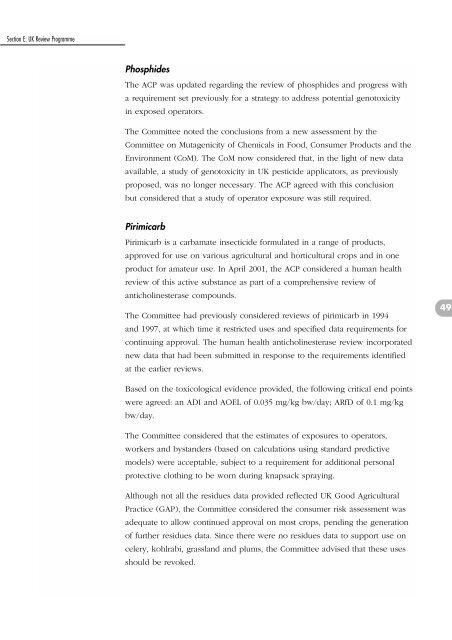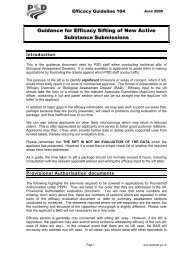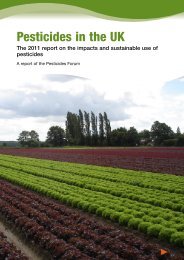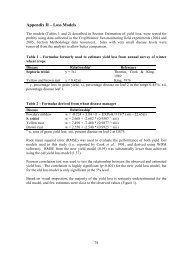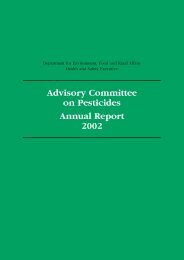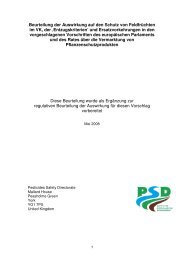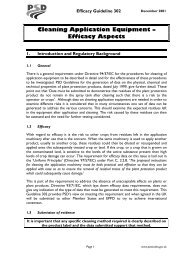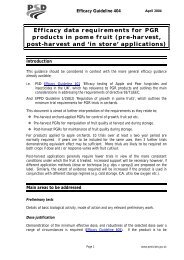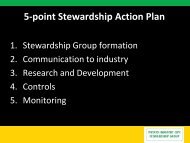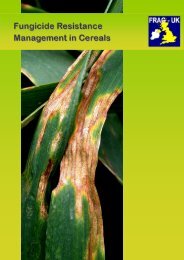Advisory Committee on Pesticides Annual Report 2001
ACP Annual Report 2001 - Pesticides Safety Directorate
ACP Annual Report 2001 - Pesticides Safety Directorate
You also want an ePaper? Increase the reach of your titles
YUMPU automatically turns print PDFs into web optimized ePapers that Google loves.
Secti<strong>on</strong> E: UK Review Programme<br />
Phosphides<br />
The ACP was updated regarding the review of phosphides and progress with<br />
a requirement set previously for a strategy to address potential genotoxicity<br />
in exposed operators.<br />
The <str<strong>on</strong>g>Committee</str<strong>on</strong>g> noted the c<strong>on</strong>clusi<strong>on</strong>s from a new assessment by the<br />
<str<strong>on</strong>g>Committee</str<strong>on</strong>g> <strong>on</strong> Mutagenicity of Chemicals in Food, C<strong>on</strong>sumer Products and the<br />
Envir<strong>on</strong>ment (CoM). The CoM now c<strong>on</strong>sidered that, in the light of new data<br />
available, a study of genotoxicity in UK pesticide applicators, as previously<br />
proposed, was no l<strong>on</strong>ger necessary. The ACP agreed with this c<strong>on</strong>clusi<strong>on</strong><br />
but c<strong>on</strong>sidered that a study of operator exposure was still required.<br />
Pirimicarb<br />
Pirimicarb is a carbamate insecticide formulated in a range of products,<br />
approved for use <strong>on</strong> various agricultural and horticultural crops and in <strong>on</strong>e<br />
product for amateur use. In April <strong>2001</strong>, the ACP c<strong>on</strong>sidered a human health<br />
review of this active substance as part of a comprehensive review of<br />
anticholinesterase compounds.<br />
The <str<strong>on</strong>g>Committee</str<strong>on</strong>g> had previously c<strong>on</strong>sidered reviews of pirimicarb in 1994<br />
and 1997, at which time it restricted uses and specified data requirements for<br />
c<strong>on</strong>tinuing approval. The human health anticholinesterase review incorporated<br />
new data that had been submitted in resp<strong>on</strong>se to the requirements identified<br />
at the earlier reviews.<br />
49<br />
Based <strong>on</strong> the toxicological evidence provided, the following critical end points<br />
were agreed: an ADI and AOEL of 0.035 mg/kg bw/day; ARfD of 0.1 mg/kg<br />
bw/day.<br />
The <str<strong>on</strong>g>Committee</str<strong>on</strong>g> c<strong>on</strong>sidered that the estimates of exposures to operators,<br />
workers and bystanders (based <strong>on</strong> calculati<strong>on</strong>s using standard predictive<br />
models) were acceptable, subject to a requirement for additi<strong>on</strong>al pers<strong>on</strong>al<br />
protective clothing to be worn during knapsack spraying.<br />
Although not all the residues data provided reflected UK Good Agricultural<br />
Practice (GAP), the <str<strong>on</strong>g>Committee</str<strong>on</strong>g> c<strong>on</strong>sidered the c<strong>on</strong>sumer risk assessment was<br />
adequate to allow c<strong>on</strong>tinued approval <strong>on</strong> most crops, pending the generati<strong>on</strong><br />
of further residues data. Since there were no residues data to support use <strong>on</strong><br />
celery, kohlrabi, grassland and plums, the <str<strong>on</strong>g>Committee</str<strong>on</strong>g> advised that these uses<br />
should be revoked.


